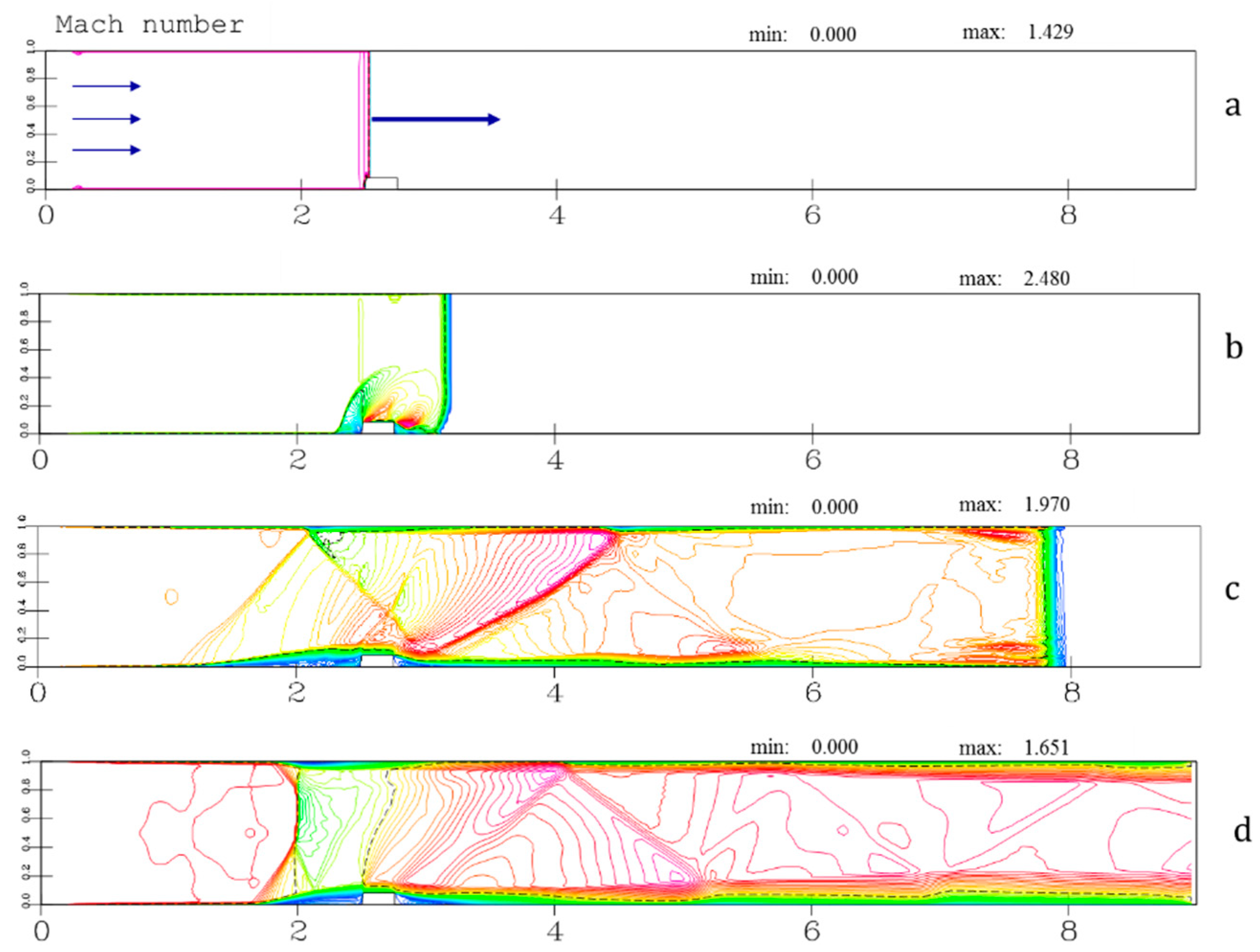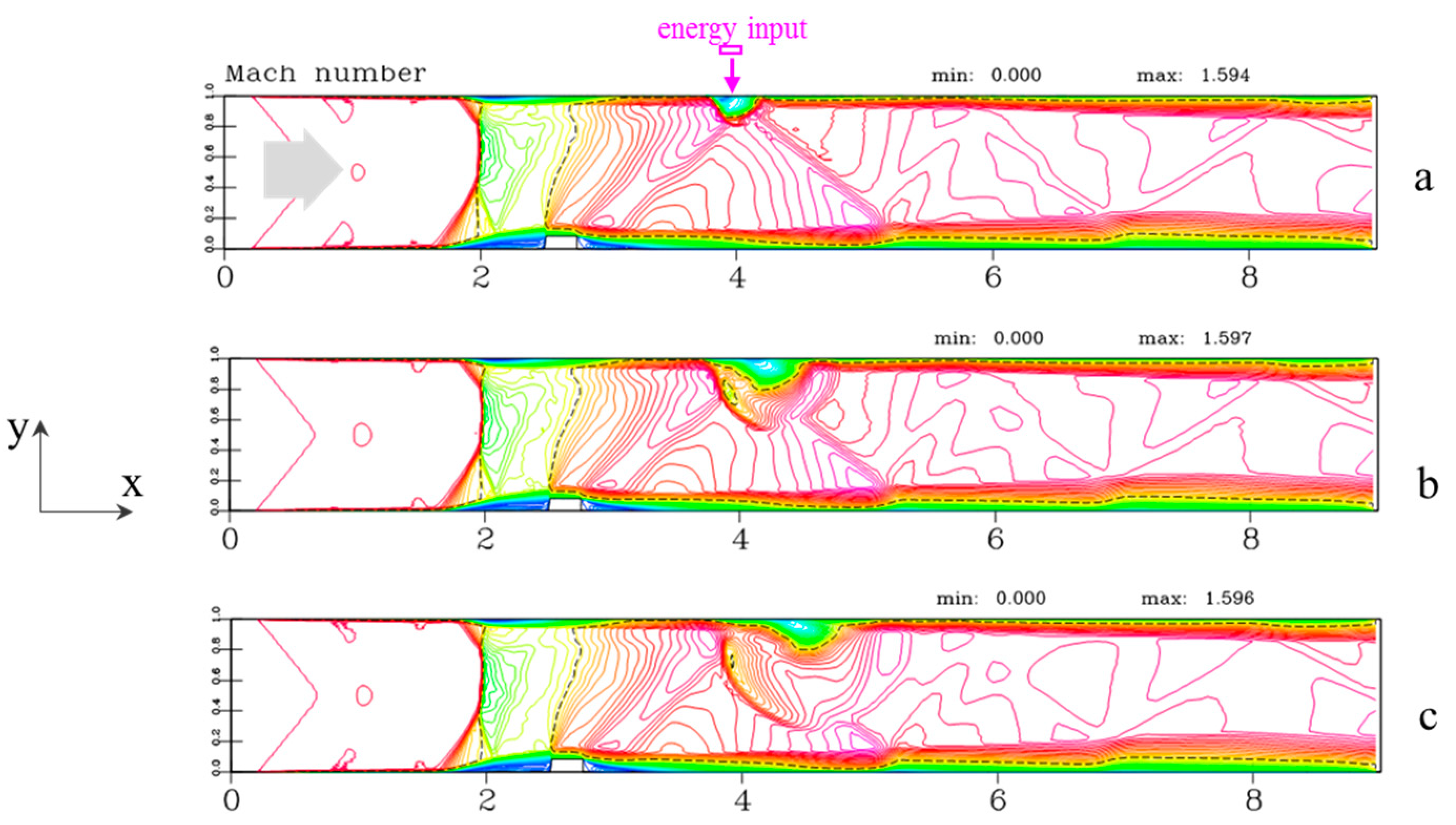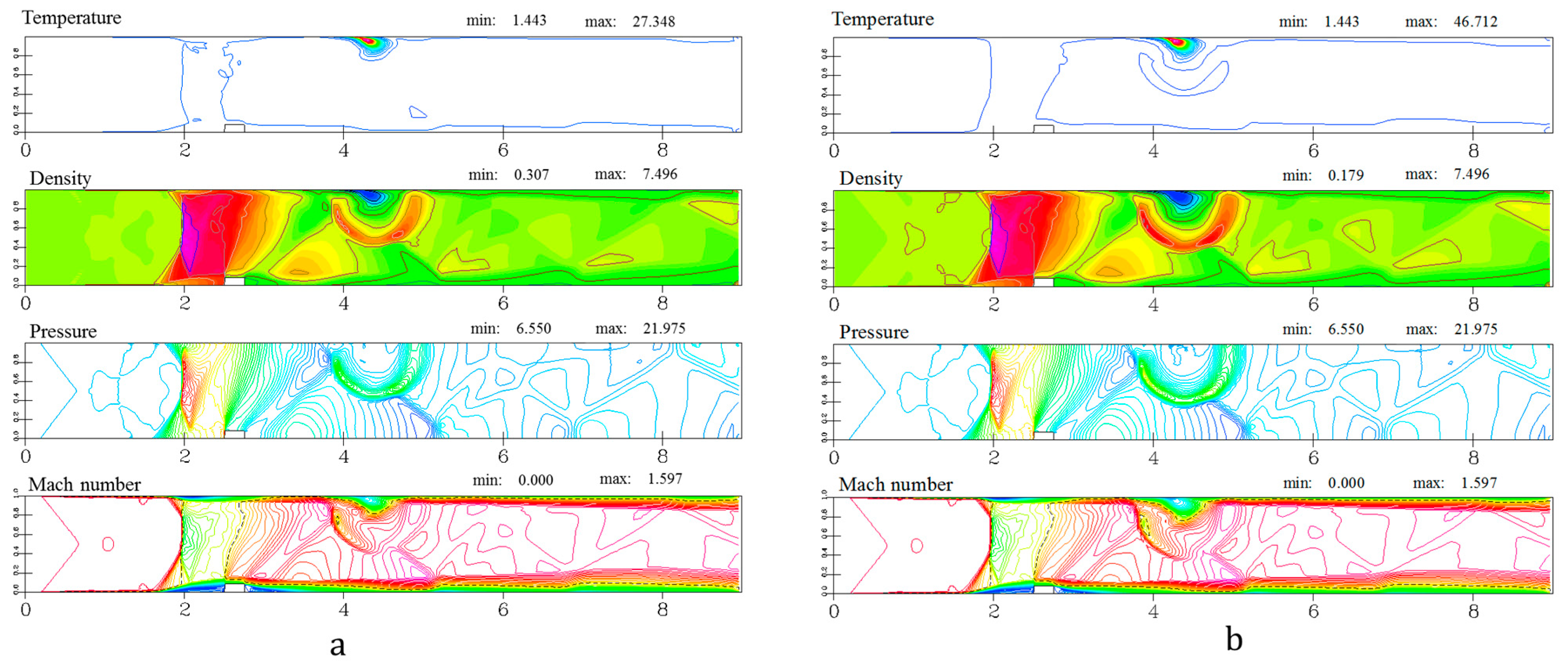Experimental and Numerical Investigation of a Surface Sliding Discharge in a Supersonic Flow with an Oblique Shock Wave
Abstract
:1. Introduction
2. Experimental Method
2.1. Experimental Setup
2.2. Surface Sliding Discharge Characteristics
3. Numerical Simulations of Supersonic Flows in a Channel
4. Results and Discussion
4.1. Shadowgraph Visualizations
4.2. Computational Analysis
5. Conclusions
Author Contributions
Funding
Institutional Review Board Statement
Informed Consent Statement
Conflicts of Interest
References
- Starikovskiy, A.Y.; Aleksandrov, N.L. Gasdynamic flow control by ultrafast local heating in a strongly nonequilibrium pulsed plasma. Plasma Phys. Rep. 2021, 47, 148–209. [Google Scholar] [CrossRef]
- Komuro, A.; Takashima, K.; Suzuki, K.; Kanno, S.; Nonomura, T.; Kaneko, T.; Ando, A.; Asai, K. Gas-heating phenomenon in a nanosecond pulse discharge in atmospheric-pressure air and its application for high-speed flow control. Plasma Sources Sci. Technol. 2018, 27, 104005. [Google Scholar] [CrossRef]
- Sugimoto, K.; Ogata, S. Highly responsive multi-flow pattern generation by multi-electrode plasma actuator using a single power supply. J. Phys. D Appl. Phys. 2022, 55, 105201. [Google Scholar] [CrossRef]
- Rodrigues, F.F.; Pascoa, J.C.; Trancossi, M. Experimental analysis of dielectric barrier discharge plasma actuators thermal characteristics under external flow influence. J. Heat Transf. 2018, 140, 102801. [Google Scholar] [CrossRef]
- Ukai, T.; Kontis, K. Thermal Fluctuation Characteristics around a Nanosecond Pulsed Dielectric Barrier Discharge Plasma Actuator using a Frequency Analysis based on Schlieren Images. Energies 2020, 13, 628. [Google Scholar] [CrossRef] [Green Version]
- Mursenkova, I.V.; Znamenskaya, I.A.; Lutsky, A.E. Influence of shock waves from plasma actuators on transonic and supersonic airflow. J. Phys. D Appl. Phys. 2018, 51, 105201. [Google Scholar] [CrossRef]
- Moreau, E.; Bayoda, D.; Benard, N. Streamer propagation and pressure waves produced by a nanosecond pulsed surface sliding discharge: Effect of the high-voltage electrode shape. J. Appl. Phys. 2021, 54, 075207. [Google Scholar] [CrossRef]
- Mehdi, G.; Bonuso, S.; De Giorgi, M.G. Effects of Nanosecond Repetitively Pulsed Discharges Timing for Aeroengines Ignition at Low Temperature Conditions by Needle-Ring Plasma Actuator. Energies 2021, 14, 5814. [Google Scholar] [CrossRef]
- Elliott, S.; Firsov, A.A.; Leonov, S.B. Oblique shock wave reflection at plasma array presence. In Journal of Physics: Conference Series; IOP Publishing: Bristol, UK, 2021; Volume 2100, p. 012008. [Google Scholar]
- Wei, X.; Zhenbing, L.; Yan, Z.; Tianxiang, G.; Yun, W.; Qiu, W. Experimental study on shock wave control in high-enthalpy hypersonic flow by using SparkJet actuator. Acta Astronaut. 2021, 188, 416–425. [Google Scholar] [CrossRef]
- Mursenkova, I.V.; Sazonov, A.S.; Liao, Y. The effect of pulsed sliding surface discharges on supersonic airflow past a thin wedge in shock tube. Tech. Phys. Lett. 2018, 44, 157–159. [Google Scholar] [CrossRef]
- Bocharov, A.N.; Mareev, E.A.; Popov, N.A. Numerical simulation of high-current pulsed arc discharge in air. J. Phys. D Appl. Phys. 2022, 55, 115204. [Google Scholar] [CrossRef]
- Kazanskiy, P.; Kotvitskii, A.; Moralev, I. Three-Dimensional Flow Structure in the Vicinity of the Pulsed Surface Arc Discharge in a Magnetic Field. Tech. Phys. Lett. 2021, 47, 565–568. [Google Scholar] [CrossRef]
- Znamenskaya, I.A.; Ivanov, I.E.; Orlov, D.M.; Sysoev, N.N. Pulsed action on a shock wave in the case of self-localized high-current surface discharge in front of the shock-wave front. Dokl. Phys. 2009, 54, 107–110. [Google Scholar] [CrossRef]
- Znamenskaya, I.A.; Latfullin, D.F.; Lutskiĭ, A.E.; Mursenkova, I.V. Energy deposition in boundary gas layer during initiation of nanosecond sliding surface discharge. Tech. Phys. Lett. 2010, 36, 795. [Google Scholar] [CrossRef]
- Saveliev, A.S. 2D simulation of interaction between separation region and gasdynamic perturbation caused by rapid heat release in supersonic airflow. In Journal of Physics: Conference Series; IOP Publishing: Bristol, UK, 2020; Volume 1698, p. 012007. [Google Scholar]
- Raizer, Y.P.; Allen, J.E. Gas Discharge Physics; Springer: Berlin, Germany, 1991. [Google Scholar]
- Liao, Y.; Mursenkova, I.V.; Ivanov, I.E.; Znamenskaya, I.A.; Sysoev, N.N. Shock waves generated by a pulsed surface sliding discharge in a supersonic airflow past a wedge. Phys. Fluids 2020, 32, 106108. [Google Scholar] [CrossRef]
- Ninni, D.; Bonelli, F.; Colonna, G.; Pascazio, G. Unsteady behavior and thermochemical non equilibrium effects in hypersonic double-wedge flows. Acta Astronaut. 2022, 191, 178–192. [Google Scholar] [CrossRef]
- Colonna, G.; Pascazio, G.; Bonelli, F. Advanced model for the interaction of a Ti plume produced by a ns-pulsed laser in a nitrogen environment. Spectrochim. Acta Part B At. Spectrosc. 2021, 179, 106120. [Google Scholar] [CrossRef]
- Georgievskiy, P.Y.; Levin, V.A.; Sutyrin, O.G. Spatial effects of interaction of a shock with a lateral low-density gas channel. Tech. Phys. Lett. 2018, 44, 905–908. [Google Scholar] [CrossRef]
- Azarova, O.A.; Lapushkina, T.A.; Krasnobaev, K.V.; Kravchenko, O.V. Redistribution of Energy during Interaction of a Shock Wave with a Temperature Layered Plasma Region at Hypersonic Speeds. Aerospace 2021, 8, 326. [Google Scholar] [CrossRef]
- Luo, Y.; Liang, H.; Li, J.; Guo, S.; Tang, M.; Kong, W. Experimental investigation of incident shock wave/boundary layer interaction controlled by pulsed spark discharge array. Exp. Therm. Fluid Sci. 2022, 132, 110515. [Google Scholar] [CrossRef]
- Koroteeva, E.; Mursenkova, I.; Liao, Y.; Znamenskaya, I. Simulating particle inertia for velocimetry measurements of a flow behind an expanding shock wave. Phys. Fluids 2018, 30, 011702. [Google Scholar] [CrossRef] [Green Version]
- Höft, H.; Becker, M.M.; Kettlitz, M. Impact of gas flow rate on breakdown of filamentary dielectric barrier discharges. Phys. Plasmas 2016, 23, 033504. [Google Scholar] [CrossRef]
- Mursenkova, I.V.; Liao, Y.; Ulanov, P.Y.; Shi, L. High-Speed Shadowgraphy of the Interaction of an Oblique Shock Wave in a Channel with a Surface Sliding Discharge. Sci. Vis. 2021, 13, 47–57. [Google Scholar] [CrossRef]
- Mursenkova, I.; Sazonov, A.; Liao, Y.; Ivanov, I. Visualization of the interaction region of an oblique shock wave with a boundary layer by the radiation of a nanosecond surface sliding discharge. Sci. Vis. 2019, 11, 76–87. [Google Scholar] [CrossRef]
- Znamenskaya, I.A.; Latfullin, D.F.; Mursenkova, I.V. Laminar-Turbulent Transition in a Supersonic Boundary Layer during Initiation of a Pulsed Surface Discharge. Tech. Phys. Lett. 2008, 34, 668–670. [Google Scholar]
- Dussauge, J.P.; Piponniau, S. Shock/boundary-layer interactions: Possible sources of unsteadiness. J. Fluids Struct. 2008, 24, 1166–1175. [Google Scholar] [CrossRef]
- Glushko, G.S.; Ivanov, I.E.; Kryukov, I.A. Computational method for turbulent supersonic flows. Math. Model. Comput. Simul. 2010, 2, 407–422. [Google Scholar] [CrossRef]
- Ivanov, I.E.; Kryukov, I.A. Numerical study of ways to prevent side loads in an over–expanded rocket nozzles during the launch stage. Acta Astronaut. 2019, 163, 196–201. [Google Scholar] [CrossRef]
- Correale, G.; Michelis, T.; Ragni, D.; Kotsonis, M.; Scarano, F. Nanosecond-pulsed plasma actuation in quiescent air and laminar boundary layer. J. Phys. D Appl. Phys. 2014, 47, 105201. [Google Scholar] [CrossRef]










Publisher’s Note: MDPI stays neutral with regard to jurisdictional claims in published maps and institutional affiliations. |
© 2022 by the authors. Licensee MDPI, Basel, Switzerland. This article is an open access article distributed under the terms and conditions of the Creative Commons Attribution (CC BY) license (https://creativecommons.org/licenses/by/4.0/).
Share and Cite
Mursenkova, I.V.; Ivanov, I.E.; Liao, Y.; Kryukov, I.A. Experimental and Numerical Investigation of a Surface Sliding Discharge in a Supersonic Flow with an Oblique Shock Wave. Energies 2022, 15, 2189. https://doi.org/10.3390/en15062189
Mursenkova IV, Ivanov IE, Liao Y, Kryukov IA. Experimental and Numerical Investigation of a Surface Sliding Discharge in a Supersonic Flow with an Oblique Shock Wave. Energies. 2022; 15(6):2189. https://doi.org/10.3390/en15062189
Chicago/Turabian StyleMursenkova, Irina V., Igor E. Ivanov, Yugan Liao, and Igor A. Kryukov. 2022. "Experimental and Numerical Investigation of a Surface Sliding Discharge in a Supersonic Flow with an Oblique Shock Wave" Energies 15, no. 6: 2189. https://doi.org/10.3390/en15062189




